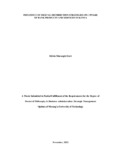Influence of Digital Distribution Strategies on Uptake of Bank Products and Services in Kenya
Abstract
banking, online payments, Automated Teller Machines, and agency banking, among others. Despite this, just 36% of clients use technology for agency banking, 31% for mobile banking, 30% for ATM banking, and 3% for internet banking. This led the researcher to investigate how banking distribution strategies influence the uptake of bank products and services. The study was conducted in 23 branches where primary data was collected using questionnaires and secondary data was collected from Family Bank and CBK's annual reports. The study addressed the four specific objectives which are: examining how Family Bank products and services products uptakes were influenced by internet banking, to explore the impact of mobile banking strategy on the adoption of products and services, examine the influence of agency banking on the adoption of bank products and services, and assess the influence of ATMs on the uptake of bank products and services. The study analyzed the literature written by other researchers on this subject, empirical studies, and the theoretical framework that served as the foundation for the conceptual framework. This study made use of the technology acceptance theory, economic distribution theory, agency theory, bank focused theory, bank-led theory, and non-bank-led theory. The study applied both descriptive and correlational research designs. The population of the study was 177,950 customers drawn from Mt Kenya r infrastructure. The study also concluded that internet banking though was statistically significant; it only constituted 3% of the users. The study recommended that further study be carried out to find out the influence of product knowledge on services and products uptake. It was noted that several customers possessed ATM cards but never used to transact with them. Further study should be carried out on the influence of customer training on products and services uptake. A policy should be formulated to ensure that once customers are registered in the strategies, they are trained on services available and use. The study finally recommends that the bank should data mine to establish the customers eligible but not registered and intensify onboarding. The study also recommends that the institution and partners ensure 100% network uptime. The study also recommends that the banks should adequately train customers on distribution strategies to increase uptake.

